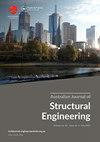基于半主动阻尼器和模糊控制器的结构振动控制
IF 1.3
Q4 ENGINEERING, CIVIL
Australian Journal of Structural Engineering
Pub Date : 2021-07-03
DOI:10.1080/13287982.2021.1957198
引用次数: 6
摘要
本文主要研究半主动阻尼器在结构控制中的应用。本文采用模糊算法1和模糊算法2作为控制器对半主动阻尼器的电压进行评估。为了设计一个合适的模糊控制器,需要对隶属函数和合适的规则集进行调优和提取。半主动阻尼器的位置对减小结构的响应具有重要意义。本文对一栋15层建筑在不同地震动作用下的非受控和受控(带有MR阻尼器)情况下的响应进行了评估。利用灰狼优化器对1型和2型模糊控制器以及3个磁流变阻尼器的位置进行了优化,并对其耗散能量进行了研究。结果表明,虽然两种优化控制器都能成功地降低建筑物的地震响应,但模糊2型控制器的性能略优于模糊1型控制器。经证实,减震器的最佳位置是在上层。本文章由计算机程序翻译,如有差异,请以英文原文为准。
Vibration control of structure by optimising the placement of semi-active dampers and fuzzy logic controllers
ABSTRACT This study concentrates on applying semi-active dampers to control structures. In this paper, fuzzy algorithm types 1 and 2 have been used as controllers to evaluate the voltage of semi-active dampers. To design a proper fuzzy logic controller, membership functions and suitable rule sets need to be tuned and extracted. The location of a semi-active damper is very significant to reduce the responses of structure. In this paper, a 15-story building’s responses for both uncontrolled and controlled (with MR dampers) situations subject to different ground motions are evaluated. Type 1 and type 2 fuzzy logic controllers, and the location of three MR dampers are optimised by Grey Wolf Optimiser, and also dissipating energies are investigated. The results show that although both optimised controllers can successfully reduce the seismic response of the building, the performance of the fuzzy type 2 controller is slightly superior than type 1. It is confirmed that the best location for dampers would be in the upper stories.
求助全文
通过发布文献求助,成功后即可免费获取论文全文。
去求助
来源期刊

Australian Journal of Structural Engineering
ENGINEERING, CIVIL-
CiteScore
2.50
自引率
0.00%
发文量
31
期刊介绍:
The Australian Journal of Structural Engineering (AJSE) is published under the auspices of the Structural College Board of Engineers Australia. It fulfils part of the Board''s mission for Continuing Professional Development. The journal also offers a means for exchange and interaction of scientific and professional issues and technical developments. The journal is open to members and non-members of Engineers Australia. Original papers on research and development (Technical Papers) and professional matters and achievements (Professional Papers) in all areas relevant to the science, art and practice of structural engineering are considered for possible publication. All papers and technical notes are peer-reviewed. The fundamental criterion for acceptance for publication is the intellectual and professional value of the contribution. Occasionally, papers previously published in essentially the same form elsewhere may be considered for publication. In this case acknowledgement to prior publication must be included in a footnote on page one of the manuscript. These papers are peer-reviewed as new submissions. The length of acceptable contributions typically should not exceed 4,000 to 5,000 word equivalents. Longer manuscripts may be considered at the discretion of the Editor. Technical Notes typically should not exceed about 1,000 word equivalents. Discussions on a Paper or Note published in the AJSE are welcomed. Discussions must address significant matters related to the content of a Paper or Technical Note and may include supplementary and critical comments and questions regarding content.
 求助内容:
求助内容: 应助结果提醒方式:
应助结果提醒方式:


